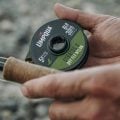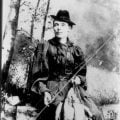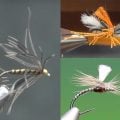How to Tie a Mop Hopper
Producer: Tim Flagler
This is my version of the Mop Hopper. It doesn’t require specialized foam cutting tools, pre-cut body parts or really any material that’s out of the ordinary. The mop abdomen not only adds to the fly’s realism but, as you’ll see, also helps it to float.
To start, I’m going to use a size 8 Lightning Strike NH7 nymph/hopper hook. I really like the look of the ring eye on this pattern.
For thread I’ve loaded a bobbin with a spool of UTC 140 Denier in fluorescent green. Get your thread started on the hook shank behind the eye and take a few wraps rearward before snipping off the tag. Continue taking wraps to completely coat the hook shank. End with your tying thread halfway between the hook point and the barb.
This chartreuse mop is made by Comet and is available in many grocery stores. Snip one of the longer tentacles free from the hide. Although not essential, a drop of super glue, here Fly Tyers Z-ment, applied at the thread location will help stop the mop material from rotating around the hook shank while you take thread wraps to anchor it. Pull the material rearward and make open spiral wraps with your tying thread up the hook to position it about 1/4 of the way down the shank from the eye.
Pick up another drop of super glue and this time use it to lightly coat the hook shank and the thread underwraps. Push down and squeeze the mop material to adhere it to the hook then take a few nice tight thread wraps to really lock it down. Pluck or trim the mop material and take thread wraps to build a gentle ramp down to the hook shank behind the eye. Once again, leave your thread at about the 1/4 point.
Cut a rectangular piece of 2mm craft foam so it’s a full hook in length and 2 hook gaps in width. Mark the midpoints of 3 sides, then snip the 2 corners off to make something that looks like home plate. Yet again, reach for the Z-ment and coat the front square edge of the foam. Fold the foam around the hook and squeeze it tight. Try to keep the majority of the body above the hook like so. Once the adhesive sets, take a few wraps of tying thread to lock the foam down and create a forward segment or head on the hopper. You should be left with something that looks like this.
Make a diagonal wrap with your tying thread and then keep taking wraps to build another segment. Although you can certainly do it later, now’s a great time to pick up a fine tipped permanent black marker and create some nice oval-shaped eyes for the hopper.
You’re going to need just a little bit of dubbing that sort of matches the body color, here, SLF prism in caddis green. A small pinch is all that’s required. Build a fairly thin dubbing noodle on your tying thread, about 1 1/2” long. Take wraps with the noodle behind the second segment to fill in the groove. Doing this will really help to maintain the correct orientation when tying in the hind legs.
Medium-sized barred round rubber leg material is my choice for all the legs on this fly. Separate two attached strands from the rest and snip them free from the hank. Now, cut a single strand of round rubber leg material in a contrasting color free from its hank.
Fold a 1/2” or so of the 2 strand segment over and lay the single strand on top of it at a diagonal. Bring the rest of that strand underneath, then over top of itself and down through the hole formed by the double strands. Pull the single strand tight. It should look something like this. Pull on the ends of the single strand to seat the knot.
Once things are tightened up, reach for the super glue and give the knot a light coat. Tugging on the single strand will help the glue set. You can then snip the short doubled-over piece of rubber legs off close, followed by the short tag end of the single leg.
Tying the legs in in this manner creates a 90 degree angle with both parts of the leg in the same plane. Repeat the procedure at the other end of the double leg material then snip it in half to form a matched pair of hopper legs. I just had the weirdest feeling of deja vu.
Lay one of the formed legs at a 45 degree angle on the far side of the hook and take a couple of thread wraps to secure it in that orientation. I’ve already trimmed the lower green part of the leg to a hook shank in length. Pick up the second matching leg assembly and repeat the procedure on the near side of the hook. Advance your tying thread forward to behind the first segment and use it to trap the butt ends of the rubber leg material there. You can then snip the excess off close. There’s a good reason for doing this, as you’ll see later.
Snip a single full strand of the contrasting rubber leg material free from the hank. Fold it in half to form a loop then place the midsection of the doubled-over material against the near side of the hook behind the first segment. Secure it with two wraps of tying thread. Relocate half the material to the far side of the hook so it lays between the double strands from the hind legs. Then do the same on the near side. Having the double strands cradle the single strand really helps to keep these front legs oriented correctly – a handy little trick that can be used on other patterns as well.
For the hopper’s wing, snip free a card-width segment of white polypropylene floating yarn. Measure to form a wing that extends just beyond the back tip of the foam. Anchor it with a few firm wraps of tying thread. You can then snip the excess butt ends off close.
To flatten the wing and increase fly visibility, I use a hole punch to create little discs of bright orange 2mm craft foam. Place one of the discs on top of the fly and secure it with a wrap or two of tying thread. Reach for the Z-ment one last time and place a small drop on top of the disc. Take a couple wraps of tying thread to draw the adhesive down into the crease and lock everything in place. Doing this allows you to simply snip your tying thread free as opposed to doing a whip finish. Snip the front rubber leg loop at its midpoint to create four front legs on the fly. Then trim these off to about a hook shank in length. And that’s all there is to tying the Mop Hopper.
It’s super important on this pattern to liberally coat the mop material and the wing with a quality liquid floatant prior to use. The mop actually sucks up the floatant and keeps the fly extremely buoyant for extended periods of time.
How to Tie a Mop 'N Glo 2.0
How to Tie a More Durable Squirmy Wormy











